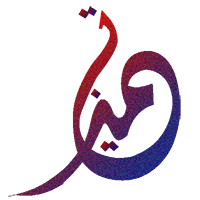Umrah (part 1 of 2)
Description: An easy to follow guide outlining the essentials every new Muslim must know about Umrah, the lesser pilgrimage.
By Abdurrahman Murad (© 2013 NewMuslims.com)
Published on 12 Aug 2013 - Last modified on 10 Apr 2017
Printed: 544 - Emailed: 2 - Viewed: 38,054 (daily average: 9)
Objectives:
·To learn the importance of Umrah.
·To learn the basic conditions associated with it.
·To learn how to perform it.
Arabic Terms
·Hajj – A pilgrimage to Mecca where the pilgrim performs a set of rituals. The Hajj is one of the five pillars of Islam, which every adult Muslim must undertake at least once in their life if they can afford it and are physically able.
·Ihram – A state in which one is prohibited to practice certain deeds that are lawful at other times. It is necessary when performing the rites of Umrah and Hajj.
·Izaar – A piece of cloth used as a waist-wrapper both by men and women.
·Jihad – a struggle, to exert effort in a certain matter, and may refer to a legitimate war.
·Kabah – The cube-shaped structure located in the city of Mecca. It serves as a focal point towards which all Muslims face when praying.
·Mahram – a person, man or woman related to a particular individual by blood, marriage or breastfeeding. One he or she is not permitted to marry, such as the father, nephew, uncle, etc.
·Miqat – A station wherein one would put on the garments of Ihram and enter the state of Ihram.
·Niqab – Face veil.
·Ridaa – A piece of cloth (sheet etc.) worn around the upper part of the body.
·Sa’ee – It is the walking and running between the hills of Safa and Marwa.
·Safa and Marwa – Hills between which people walk and run during the Umrah.
·Talbiyah – The proclamation Muslims chant during the pilgrimage.
·Tawaf – Circumambulation around the Kabah. It is done in seven circuits.
·Umrah – A pilgrimage to the Holy House of Allah in the city of Mecca, Saudi Arabia. Often referred to as the lesser pilgrimage. It can be performed at any time of the year.
Importance of Umrah
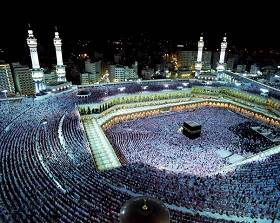 Its importance is found in numerous texts; we will list them
here in point form:
Its importance is found in numerous texts; we will list them
here in point form:
1.“Be consistent and perform Umrah after having performed the Hajj; for indeed it will remove poverty and sins in a manner similar to a blacksmith who would purify iron, gold and silver. Indeed the accepted Hajj has no reward except Jannah (Heavenly Abode).”[1]
2.“Performing an Umrah followed by another will efface all the sins between the two.”[2]
3.“The Jihad for the elderly, weak and women is Hajj and Umrah.”[3]
Pillars of Umrah
There are three pillars of Umrah:
Ihram
Tawaf
Sa’ee
Ihram: Ihram refers to a state that one enters, wherein one is prohibited from doing certain things. These include wearing perfume, clipping nails or cutting hair and covering the head with direct head-gear.[4] A man wears two sheets called “Izaar” and “Ridaa” and he should leave his head uncovered. The “Ridaa” covers the upper part of the body, whereas, the “Izaar” covers the lower part of the body.
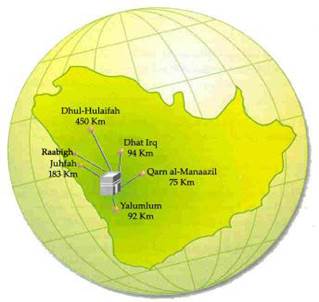 A woman can wear her regular clothing, but she should not
wear gloves or a “niqab”. She may draw her headscarf over her face in
the presence of non-mahram men.
A woman can wear her regular clothing, but she should not
wear gloves or a “niqab”. She may draw her headscarf over her face in
the presence of non-mahram men.
Tawaf: It is the circumambulation around the Kabah. A person does this seven times.
Sa’ee: It is the walking and running between the hills of Safa and Marwa.
These are the three pillars of Umrah. Umrah also has two compulsory acts that must be met:
1.Entering the state of Ihram from outside the Haram (sanctuary) area (from a Miqat station).
2.Shaving or shortening the hair (for a man) and clipping a small portion for a woman.
Procedure of Umrah
Once a person arrives at the Miqat station, whether this is by land or by air they must put on the necessary clothing of Ihram. A man may wear perfume on his body before entering the state of Ihram, if he chooses, but not on his garments. He should not apply perfume after entering the state of Ihram.
Before leaving the Miqat station, one should say: “Labbaik Allaahumma bi ’Umrah” (Here I am O Allah in response to Your call performing Umrah). Upon saying this one enters the state of Ihram.
They would then begin to chant the Talbiyah saying: “Labbaik Allaahumma labbaik, labbaika laa shareeka laka labbaik, innal-hamda wan-ni’mata laka wal mulk, laa shareeka lak”[5].
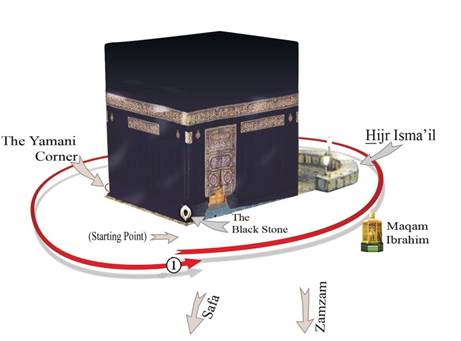 They continue to chant this until they reach the Kabah and
begin to perform the Tawaf. A man is to uncover his right shoulder
throughout the Tawaf; this is done by placing the middle part of the Ridaa
under the right arm and tossing both ends of the sheet on the left shoulder.
They continue to chant this until they reach the Kabah and
begin to perform the Tawaf. A man is to uncover his right shoulder
throughout the Tawaf; this is done by placing the middle part of the Ridaa
under the right arm and tossing both ends of the sheet on the left shoulder.
Thereafter one is to circumambulate around the Kabah
seven times; each time begins from the Black Stone. One is not required to
physically touch or kiss it, but when one is in line with it, they begin their
circumambulation at that point. During the Tawaf one should be mindful
of Allah, asking of Him and begging for His mercy. One should avoid 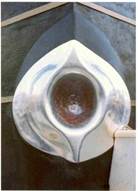 idle talk and laughter, for this maybe a once in a lifetime
chance which should not be squandered heedlessly!
idle talk and laughter, for this maybe a once in a lifetime
chance which should not be squandered heedlessly!
It is praiseworthy for one to walk with a faster pace in the first three rounds.
The Prophet, may the mercy and blessings of Allah be upon him, would say the following between the Yemeni corner and the Black Stone:
Rabbanaa aatina fid-dunya hasanah wa fil-aakhirati hasanah wa qina ’adhaban-naar
Meaning: O our Lord, bless us with goodness in this life and in the next life as well and save us from the torment of Hell.
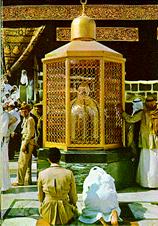 When the seventh round is finished, one should cover their
shoulder and perform a two unit prayer behind Maqam of Ibrahim (Station
of Ibrahim[6]).
If this is not possible (due to crowds) then one can pray anywhere in the
Mosque.
When the seventh round is finished, one should cover their
shoulder and perform a two unit prayer behind Maqam of Ibrahim (Station
of Ibrahim[6]).
If this is not possible (due to crowds) then one can pray anywhere in the
Mosque.
After the prayer one should drink the Zamzam water for it is blessed. The Prophet said: ‘Zamzam water is for what it was drunk for.’[7]
With this, the first segment of the Umrah is complete. As one approaches the hill of Safa they are to recite:
“Innas-safaa wal-marwata min sha’aa-iril-laah, faman hajjal-baita a-wi’tamara falaa junaaha ’alaihi an yat-tawwafa bi-hi-maa wa man ta-tawwa’a khairan fa-innallaaha shaakirun ’aleem.”
Meaning: Indeed, as-Safa and al-Marwah are among the symbols of Allah. So whoever makes Hajj to the House or performs Umrah - there is no blame upon him for walking between them. And whoever volunteers good - then indeed, Allah is appreciative and Knowing. (Qur’an 2:158)
After this one should say: “Ab-da’u bi-maa bada-allaahu bihi.”
Meaning: I begin with what Allah has begun with.
This is only said at the first time.
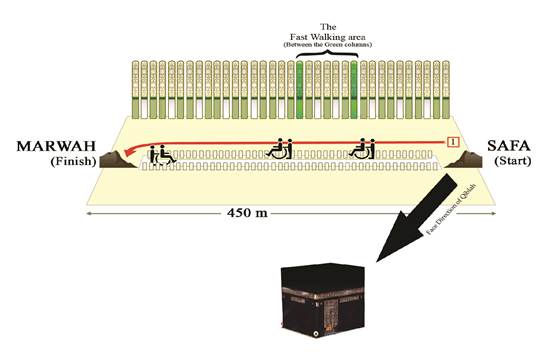 After this, one walks towards the slight incline on the hill
of Safa and then faces the Kabah. This is a time where
supplication is accepted and one should repeat their prayers three times.
After this, one walks towards the slight incline on the hill
of Safa and then faces the Kabah. This is a time where
supplication is accepted and one should repeat their prayers three times.
After this, a person should walk between the hills of Safa and Marwa and run between the green lights, until they reach the hill of Marwa. Here one is to supplicate as they did at the hill of Safa. This trip between the hills of Safa and Marwa is considered one trip; a person does seven trips starting from Safa and ending at Marwa.
The last step in the Umrah is to shorten or shave the hair for a man and to clip a small portion for a woman. With this the Umrah is completed.
In part two we will discuss important issues that pertain to Ihram and discuss important tips that one should be aware of when performing Umrah.
Footnotes:
[1] Tirmidthi
[2] Saheeh Al-Bukhari
[3] An-Nasa’ee
[4] More information on this is found in part 2.
[5]Meaning: Here I am O Allah in response to Your call, here I am. Here I am, You have no partner, here I am. Verily all praise, grace and sovereignty belong to You. You have no partner.
[6] This is the point where Prophet Ibrahim stood to build the Kabah.
[7] Ibn Hibban
Previous Lesson: Ramadan: The Last Ten Nights
Next Lesson: Umrah (part 2 of 2)
- Voluntary Prayers
- Treatment of Animals
- Lying, Backbiting and Slander (part 1 of 2)
- Lying, Backbiting and Slander (part 2 of 2)
- Increasing Faith (part 1 of 2): Why faith is not always at asteady level
- Increasing Faith (part 2 of 2): Increase your faith (Imaan)and earn rewards
- Voluntary Fasts
- Signs of the Day of Judgment (part 1 of 2): The Minor Signs
- Signs of the Day of Judgment (part 2 of 2): The Major Signs
- Adultery, Fornication, & Pornography (part 1 of 2)
- Adultery, Fornication, & Pornography (part 2 of 2)
- Islamic Guidelines for Gender Interactions(part 1 of 2)
- Islamic Guidelines for Gender Interactions (part 2 of 2)
- Introduction to Shariah (part 1 of 2)
- Introduction to Shariah (part 2 of 2)
- Acts that Correspond to Human Nature (Sunan ul-Fitrah)
- Eid ul-Adha from A to Z (part 1 of 3)
- Eid ul-Adha from A to Z (part 2 of 3)
- Eid ul-Adha from A to Z (part 3 of 3)
- Innovation in Islam (part 1 of 2): Two Types of Bidah
- Innovation in Islam (part 2 of 2): Is this a bidah?
- Ramadan: The Last Ten Nights
- Umrah (part 1 of 2)
- Umrah (part 2 of 2)
- Concept of Sins in Islam (part 1 of 3)
- Concept of Sins in Islam (part 2 of 3)
- Concept of Sins in Islam (part 3 of 3)


